I Can’t Believe We Did This: Mountain Climbing in Whistler
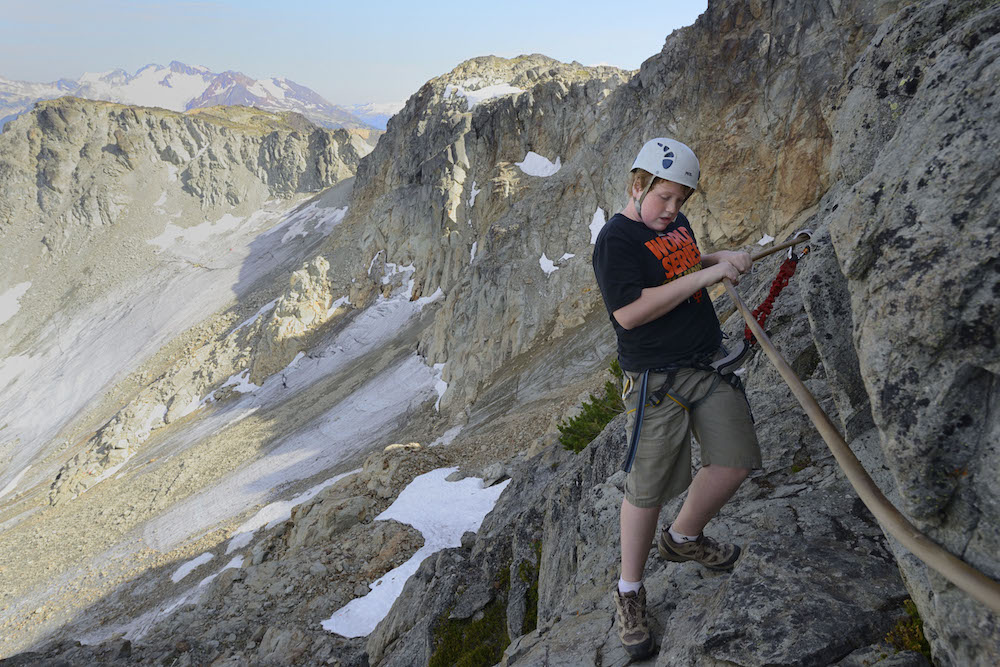 Charlie negotiates one of several transverses between climbing sections. Photo: Timothy Baker
Charlie negotiates one of several transverses between climbing sections. Photo: Timothy Baker “In Whistler we’re doing the Via Ferrata,” Wendy announced proudly. Sounds good, I thought. Must be like “doing” Las Ramblas in Barcelona. But with an Italian twist. Never having been to Whistler, I pictured some street lined with cappuccino and gelato shops and small tables for people-watching. “Not exactly,” she said. “Via Ferrata means ‘iron way’ in Italian. You use iron rungs drilled into the rock face to climb a mountain. We’ll be climbing Whistler Mountain.”
Wait. What? Wendy had signed the family up to climb a rock face? The boys would love it, of course—they’d bungee jump from a moving space shuttle if they could. But I had just had total knee replacement surgery six months earlier. And, while I love Wendy, her rock-climbing abilities are minimal. Did we really need to climb Whistler Mountain? A chairlift goes right to the summit. Whose idea was this anyway? “Steve Ogden from Tourism Whistler.”
Please note that if I, and not Steve, had suggested Wendy climb a mountain, my compos mentis would have been called into question and proceedings to institutionalize me started. But Steve from Tourism Whistler had suggested it. And the Via Ferrata is one of the mountain’s best-kept secrets; very few locals have heard of it. So, of course, Wendy was willing to try it. Anything for a story.
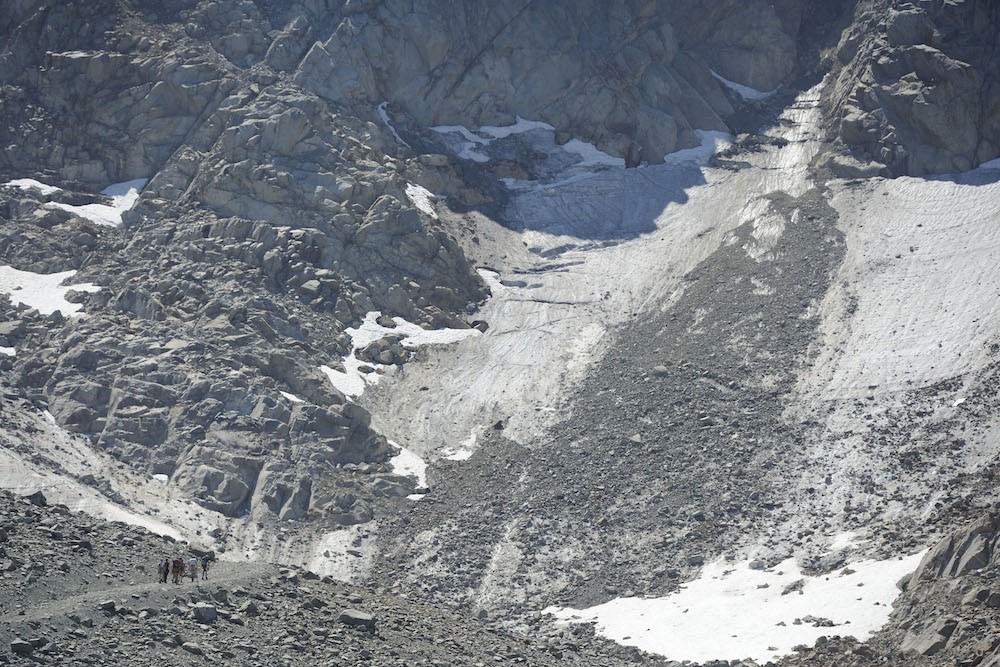
The group ahead of us (at lower left) is dwarfed by the mountain. Photo: Timothy Baker
And so, on a perfect mountain afternoon, we met our guide, Josh Majorossy, at the Whistler Alpine Guides headquarters a little above Whistler Mountain’s Roundhouse Lodge complex (elevation 6,069 feet). I saw a group returning from the morning climb and, trying to glean a little intel, asked how it was. “Brilliant,” they delivered in a British accent. Okay. But is there anything I should know about it? “It was just brilliant.” Thanks.
Josh was an extremely patient and laid-back fellow—a professional mountain guide who does the climb twice a day and has led hundreds of groups. He assured me that my knee would be fine. He assured Wendy that mountain-climbing novices of only average fitness can do this. “If you can climb a ladder, you can climb the mountain.”
After waiver signing (a popular Whistler tourist activity), we each got kitted up with a hard hat and a harness with two lanyards and carabiners, and we had a brief safety chat. Safety rule #1: One of your lanyards and carabiners must be attached to the safety cable at all times. Rule #2: Yell “Rocks!” if any are dislodged. Rule #3: When someone above you yells “Rocks!,” don’t look up. Rule #4: Only one person at a time can be attached to a segment of safety cable; that way, if you stumble and fall, you won’t take out the people below you.
Earlier in the season, when snow is present, you traverse the snow to the spot where the rungs start. In early August, though—when we did it—you hike down and back up again to the trail. The hike down was a simple walk, but the hike up was actually what mountain climbers call “scrambling.”
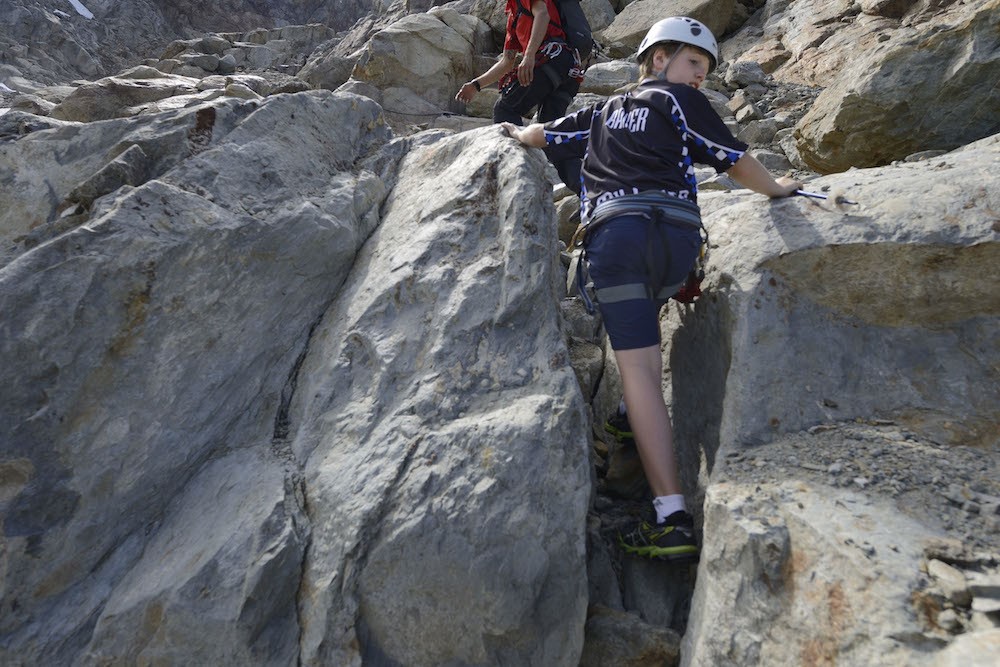
Carrying a broken ski pole he found, Doug scrambles through a crack in the rock. Photo: Timothy Baker
Scrambling is climbing and clambering over rocks freestyle, with no set trail. The boys were in boy heaven. I was worried because we weren’t to the beginning of the safety cable just yet. If they fell, other rocks would break their fall.
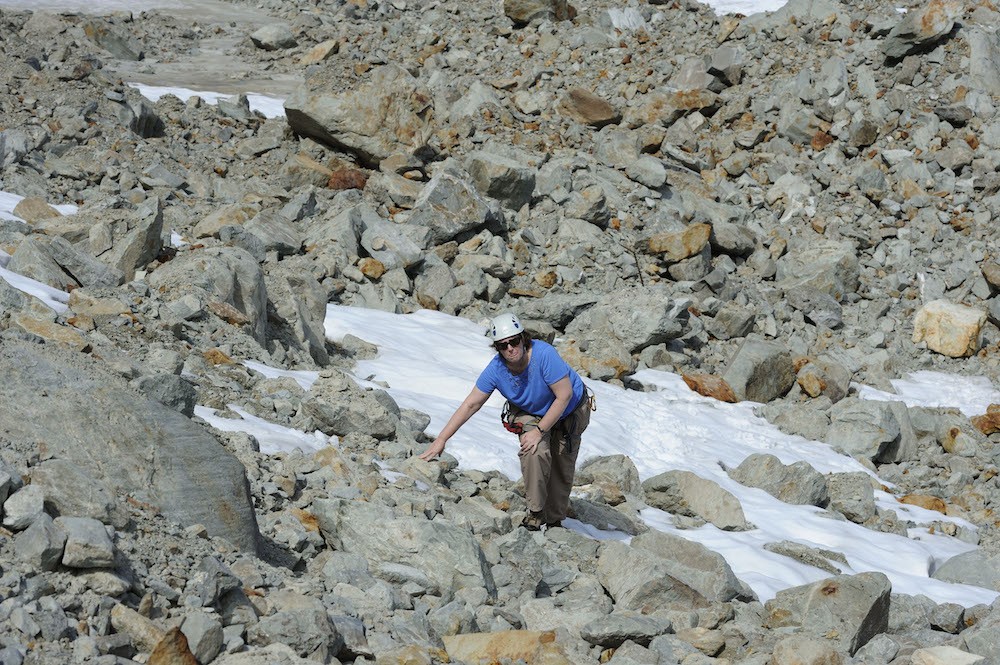
Wendy is more at home in the canyons of Manhattan than scrambling up a mountain peak. Photo: Timothy Baker
In the distance, we could see the group ahead of us. So we could see where we were expected to go. Up there? Really?
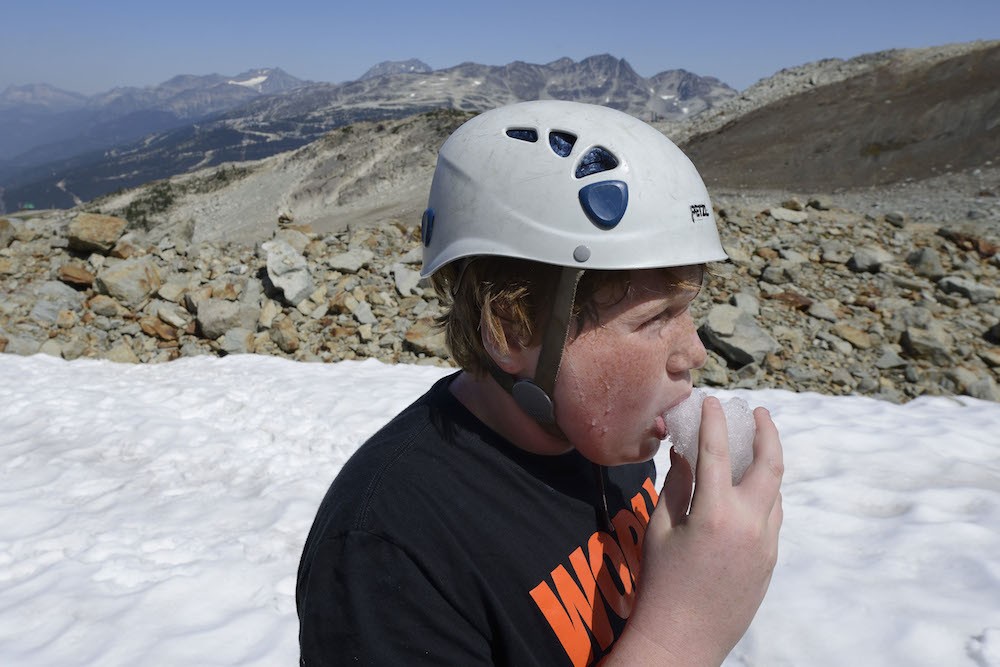
Charlie stops for a little natural refreshment. Photo: Timothy Baker
At the starting point of the climb came our first gut check. There were several aluminum ladders attached via cables to the mountain and going almost straight up.
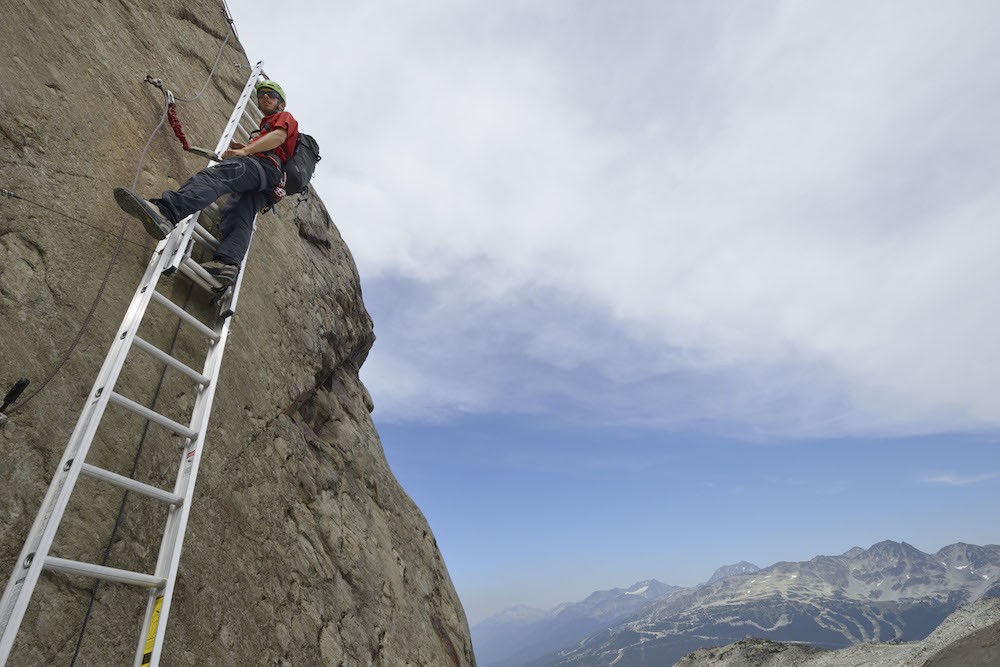
Our first gut check. Josh leads the way up the ladder to the start of the trail. Photo: Timothy Baker
Each of us clipped both our lanyards to the first safety cable. We started the climb, leap-frogging one set of lanyards and carabiners over the other every six feet or so past where the cable was anchored.
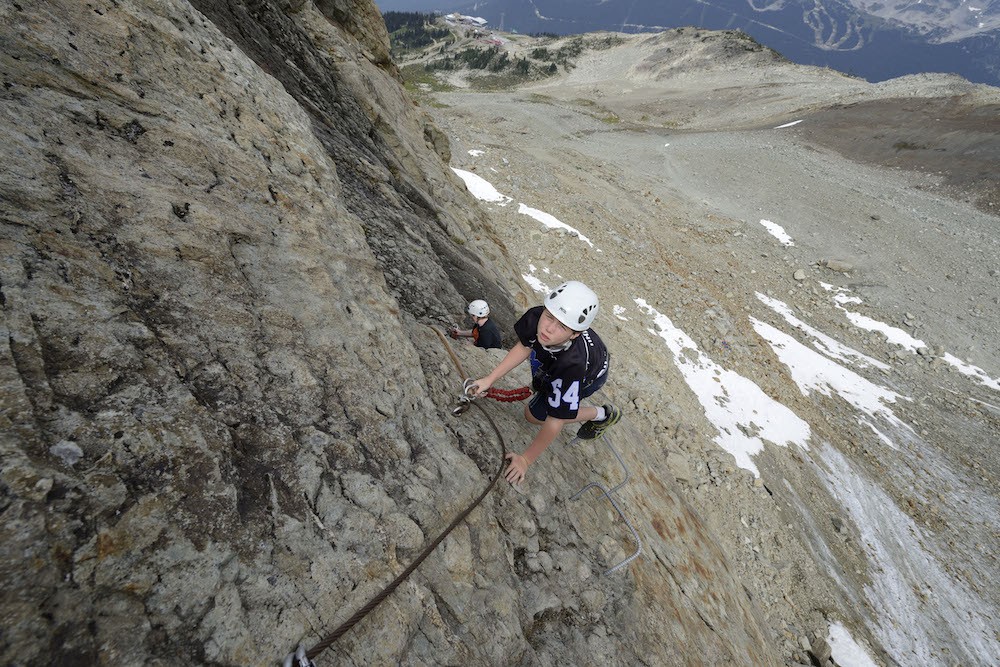
Doug climbs the first series of rungs. Photo: Timothy Baker
As Dad, I was constantly watching everyone’s lanyards to make sure that the carabiners had properly attached and closed. If one of us were to stumble and fall, we would fall only as far as the next safety-cable anchor.
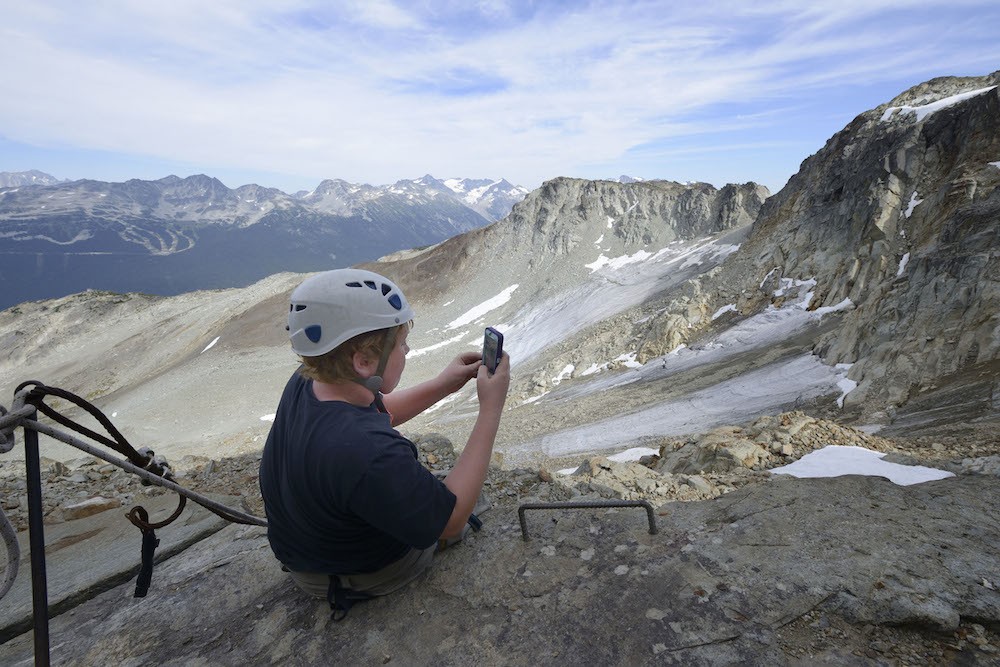
A natural ledge makes a perfect place for Charlie to use panorama mode. Photo: Timothy Baker
On several occasions we witnessed natural rock slides: Steamer-trunk-sized boulders, probably loosened by the weight and thawing of the snow and ice, broke off the mountain peak and slid down the snow chute well away from our vertical trail.
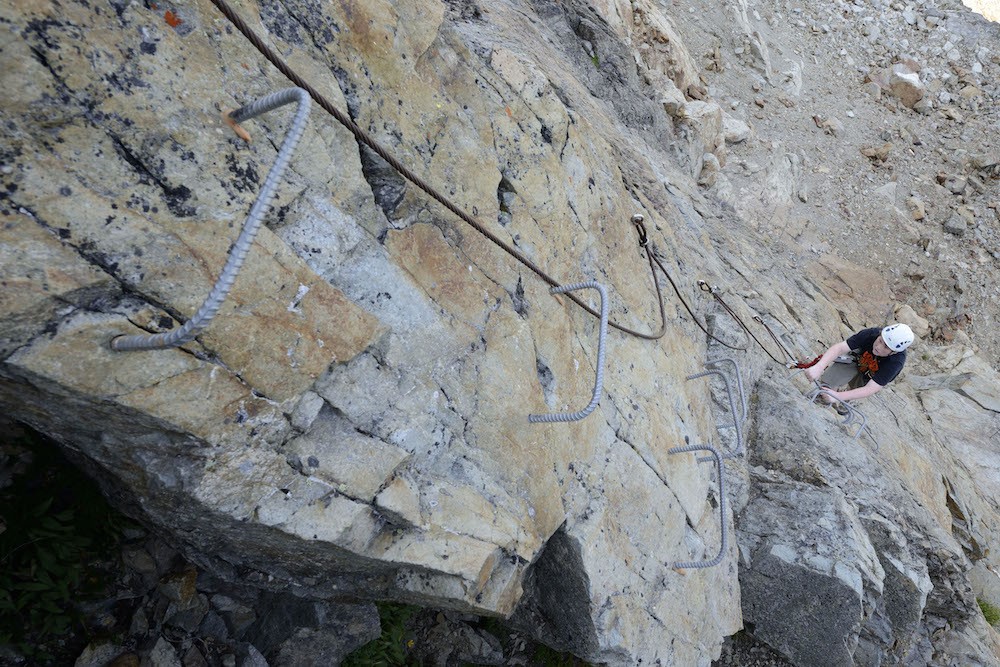
Back on the climb. Photo: Timothy Baker
The rungs themselves are not actually iron. They’re steel rebar inserted into holes drilled into the rock and epoxied in place. (“Via Rebar” just doesn’t sound exotic enough for marketing.) The experience is sometimes like climbing a ladder, but sometimes the rungs are at uneven intervals, or are offset, or both. In several spots there were no rungs at all, as there were natural handgrips and footholds in the rock. Josh challenged us to try not to use the rungs if we could use the natural rock (while still attached to the safety line, of course). The boys took the challenge whenever they could. Wendy did not.
There were a couple of tricky sections (called “technical” by real mountain climbers) where a bit of reach was needed to grab the rungs. On the toughest section, it was a little like a game of Twister. (Left foot blue. Right hand blue.) In that section Wendy needed encouragement from Josh (and his climbing rope).
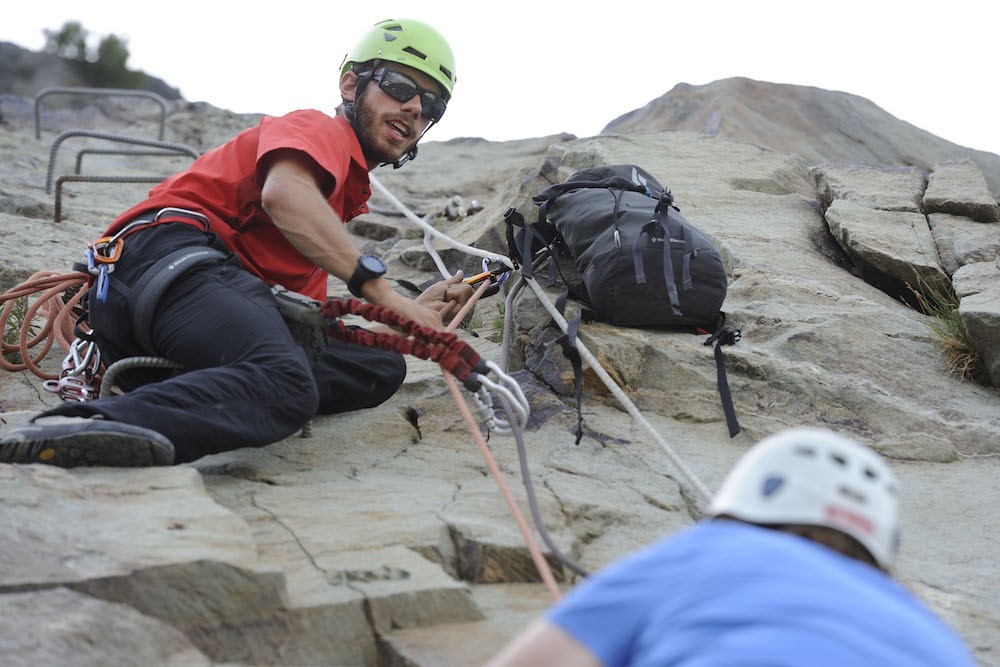
Mountain guide Josh gives Wendy a little physical encouragement. Photo: Timothy Baker
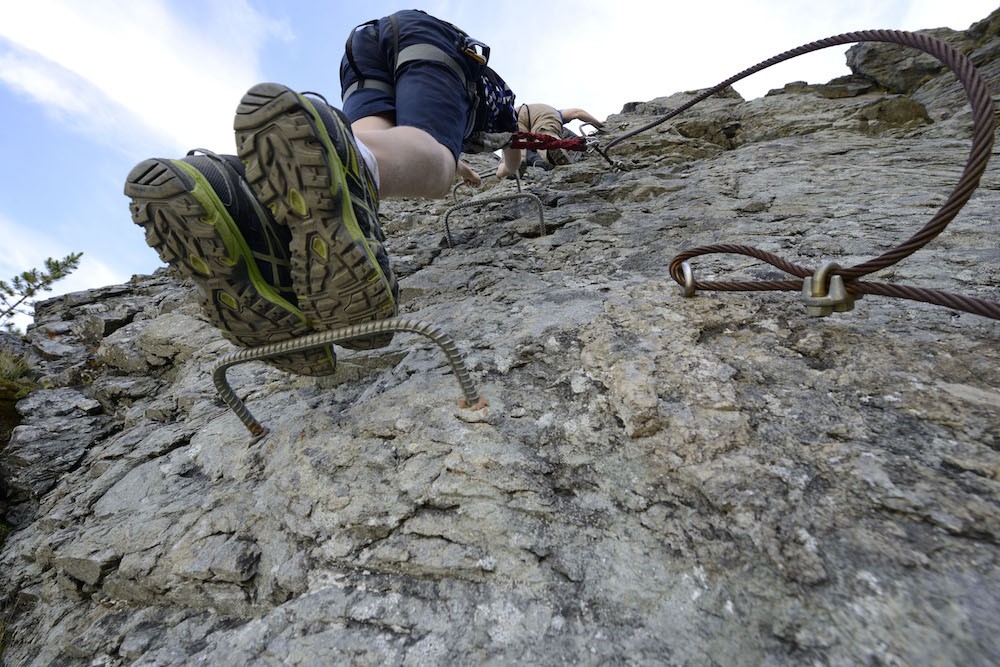
If the toes of Doug’s shoes give out, I’m wearing him. Photo: Timothy Baker
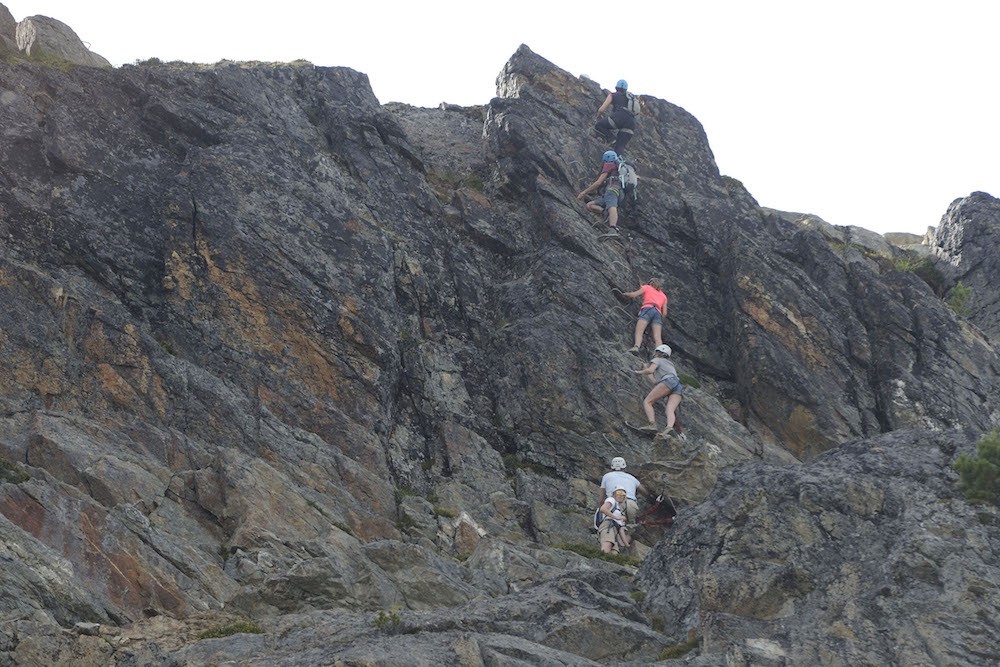
From below, we could see the early group on the last section of the climb. Photo: Timothy Baker
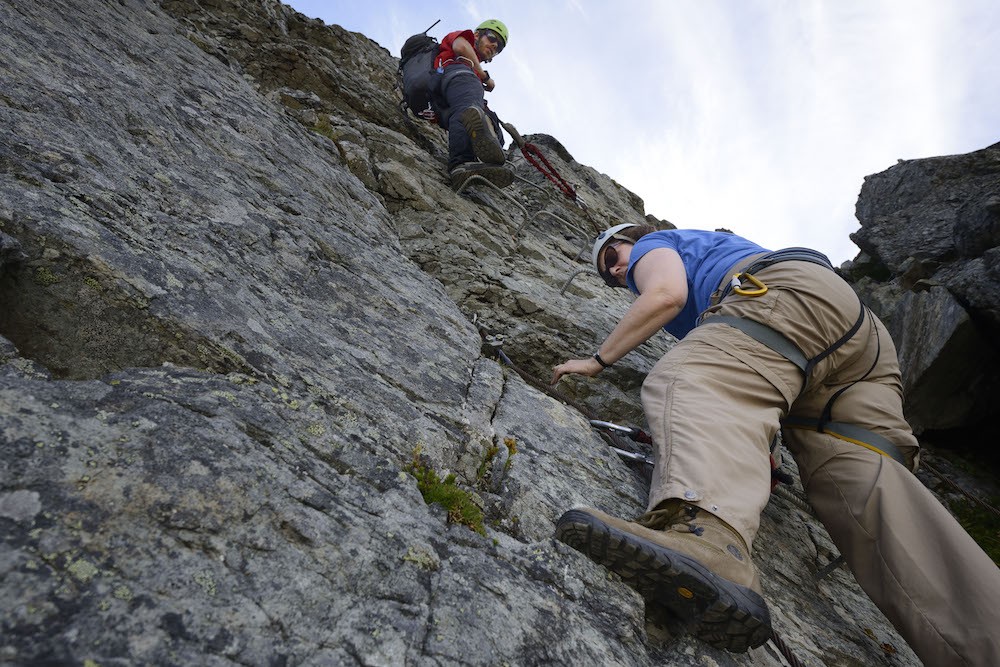
Wendy uses a natural foothold where there weren’t any rungs. Photo: Timothy Baker
We probably took a little more time than most groups because I didn’t want to unnecessarily stress my knee or my wife. The final “push” to the top of the trail—at 7,160 feet—was straight up. As we cleared the top of the trail, it was a little weird to see all the people who had ridden the chairlift up.
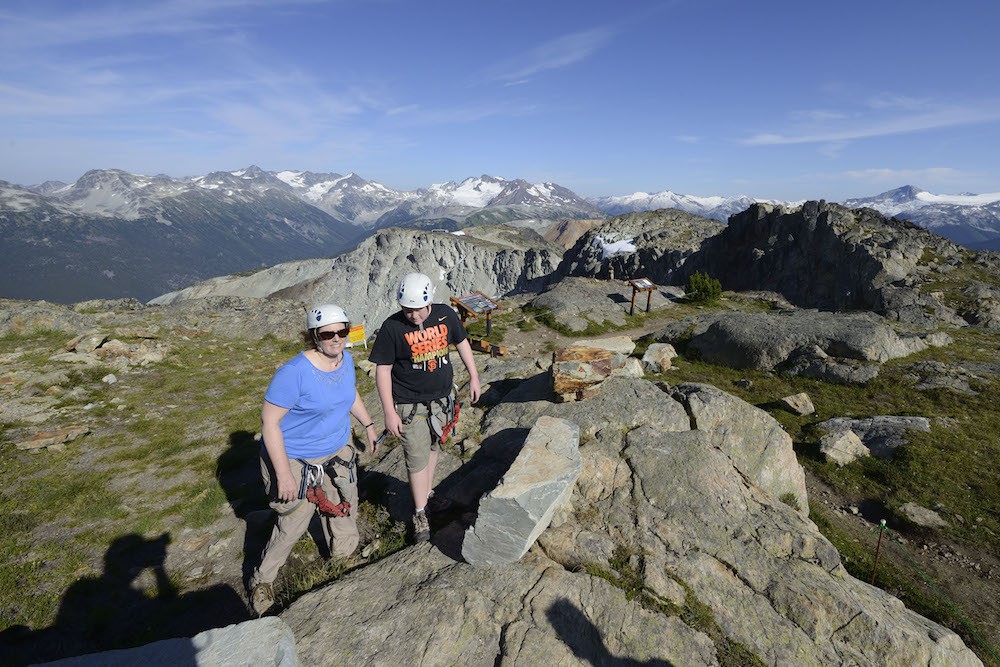
The summit. The views were our reward. Photo: Timothy Baker
Typically we are them: mere passengers in our adventure travels. This time, though, we had gotten up there the hard way—and it gave us a sense of accomplishment that is rare. We also felt relief that (1) we were coming back with the same number of (un-mangled) kids we’d started with. (2) I didn’t need to be winched off the mountain because of my knee. (3) None of my cameras had smashed into the rocks. This was Alpine Climbing 101 and a great introduction to a sport I will never take up.
In the end, the Via Ferrata turned out to be a wonderful family experience—and probably yielded our 2015 Christmas card photo. Yes, we had sore muscles, but we were able to soothe them that night with umbrella drinks in the Fairmont Chateau Whistler’s hot tubs.
From now on, when we hear of a ski or mountain-bike competition at Whistler, we’ll smile to ourselves and think: We conquered that mountain!
Need to know:
- Via Ferrata can be found all over the world.
- Bring a wide-angle lens and wear your camera strap so that the camera won’t smash against the rocks.
- Bring a light jacket or windbreaker. The weather can get a little chilly at the summit, even when it’s warm down in the valley.
- Hiking boots are very useful, but 11-year-old Doug had no problems with a harder soled sport shoe.
- Long pants are a good idea. They can handle scrapes better than your skin.
- Go at your own pace. Take the afternoon trip so you are not worried about holding up another group. You may want to hire a guide for a private tour.
- Bring a bottle of water. If the streams are running, empty out the bottle and refill with that delicious water.
- We left our sandals and comfortable shoes at the Alpine Guides hut. Nice to get off our boots and put those on after the climb.
- Light gloves are suggested. The safety cable can have a few burrs in it, and you may find yourself grabbing it.
- Use the bathroom before you start.
- Don’t forget to enjoy the magnificent panoramas.
Whistler isn’t the only ski resort where you can enjoy a multitude of warm-weather adventures; find more ideas in Summer Vacation at a Ski Resort? Yes, and Here’s Why. If you’d like help planning your own trip to Whistler (or Vail, or Park City…) click on the black button below.
Be a smarter traveler: Sign up for Wendy’s weekly newsletter to stay in the know. Read real travelers’ reviews, then use the black CONTACT buttons on Wendy’s WOW List to reach out to the right local fixer for your trip.

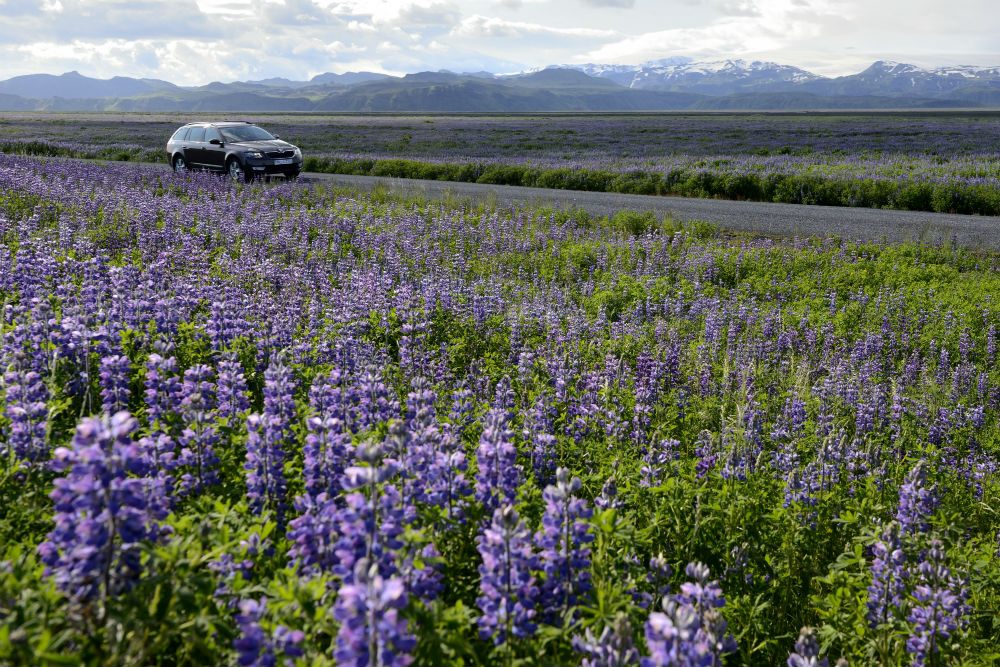
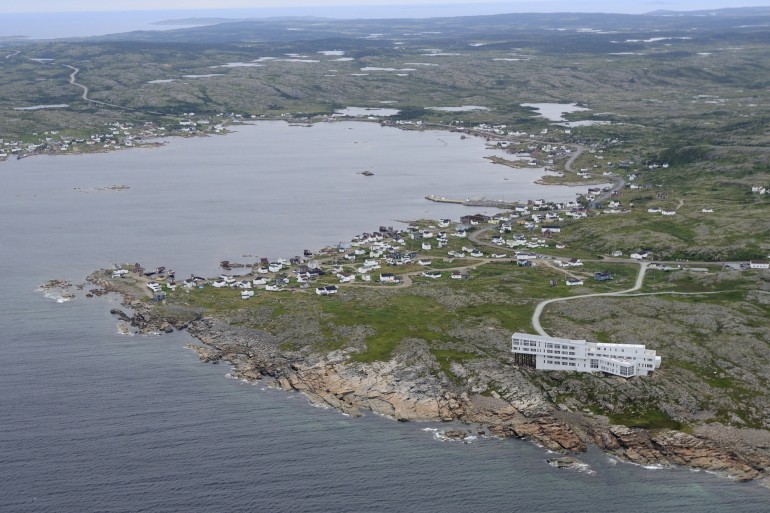







Since we did the Via Feratta in Whistler in 2016 because of this article, it has now become a must do activity on our trips. We have now done Via Feratta in Banff and in Mont Tremblant. Thank you for the suggestion. My wife and I and our three kids love it!!!!!
We are booked for Whistler! Thank you Wendy and Tim for the great articles and pictures. You have inspired us! We know with wendyperrin.com we can’t go wrong! We can’t wait for our family trip!
We did the Via Ferrata with Josh a few years ago….we still marvel that we did it! Was just as you described!
Way to go Wendy & the Baker boys. You guys are now all set for your first Himalayan experience! Great ‘trekking peaks’ with amazing views all across Nepal, Tibet and India. No technical climbing – promise; just hiking and few thousand feet of elevation.